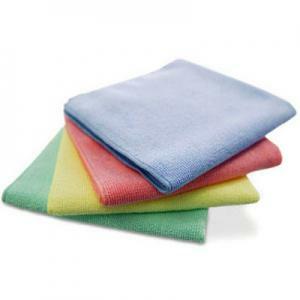
- What is the danger of dust?
- What rags are suitable for dust removal?
- Dust cloth with your own hands
- Useful advices:
A certain amount of dust accumulates daily on the surfaces in the house. Everyone knows that it must be cleaned, but not everyone knows that not every dust is suitable for dust. A hard cloth spoils the surface, wet - it does not work well on the varnished furniture, and the dry one simply can not remove dust. In this article, you will find out which rags are best for such cleaning. How to make a universal rag that can not only clean the dust in a qualitative way, but also prevent its appearance.
to the contents ↑What is the danger of dust?
 Dust is a hard fine particle of mineral or organic origin. Even in a tightly closed room for 14 days, more than 12,000 particles settle on the surfaces. The very ingress of dust into the human body can cause difficulty in breathing and coughing. In addition, in a large number of such debris there are mites-saprophytes, which leads to major health problems.
Dust is a hard fine particle of mineral or organic origin. Even in a tightly closed room for 14 days, more than 12,000 particles settle on the surfaces. The very ingress of dust into the human body can cause difficulty in breathing and coughing. In addition, in a large number of such debris there are mites-saprophytes, which leads to major health problems.
Accumulation of dust leads to such consequences:
- allergic reactions;
- urticaria;
- chronic bronchitis and asthma;
- itching and scabies.
What rags are suitable for dust removal?
Ordinary rags for dust from old clothes are not capable of completely eliminating the entire plaque and mites - they leave up to 40% of microparticles.
Synthetic panicles are usually treated with an antistatic solution, which subsequently attracts dust with a double force.
Knowing the relevance of the fight against dust, manufacturers produce specially designed rags and napkins. They are made of cellulose and microfiber.
Pros of such materials:
- work in a dry and wet form;
- does not leave streaks and villi on the treated surfaces;
- carefully work with delicate materials: glass, wood, metal;
- can be used with special tools.
Important! Before purchasing such a rag for dust, test it for ductility. The quality material should not release the debris particles back, so it should be stretched 2 times.
to the contents ↑Dust cloth for your own hands
There are several ways to make a good absorbent rag for dust at home. For this you will need time and materials:
- water;
- lemon oil;
- gauze or soft cloth;
- glycerin.
First, prepare the fabric. To do this, follow these instructions:
- Take a meter of soft cloth or gauze.
- Cut in half - you will get two removable helpers.
- Fold the material in half.
- Process at the edges with a stitched seam.
Important! If you are a craftswoman, sew a mitten from the chosen fabric. This kind of rag is easy to handle.
 Now this material needs to be treated with special solutions for the qualitative neutralization of dust and dust mites.
Now this material needs to be treated with special solutions for the qualitative neutralization of dust and dust mites.
Method # 1
You will need lemon oil and water. A step-by-step instruction is:
- In 0.5 liters of boiling water, add ¼ lemon oil.
- Stir until homogeneous. Soak in the resulting solution cloth.
- Press and dry.
Method No. 2
In this case, treat the dust with water and glycerin for dust as follows:
- For 900 ml of warm water, take 100 ml of glycerin.
- Stir well the ingredients.
- Soak the fabric with the resulting liquid.
- Dry.
Important! Such simple tips will help you make quality dust cloths on your own. Believe me, they will serve you even much longer than special products from brand manufacturers!
to the table of contents ↑Useful advices:
- In a private house with a fireplace or stove, clean the soot in a timely manner.
- Seal all cracks with sealant so that dust does not enter the house from the outside.
- Inspect the hoods, ventilation systems and air ducts regularly for any malfunction.
- Clean the surfaces more often. Make sure that the unit is working properly and with a clean dust collector.
- Do wet cleaning every two days.
- Three times a month, do general cleaning: wipe hard-to-reach places, books, move out cabinets and sofas. Wash the walls and skirting boards.
- Wash bed linen more often.
- Knock out pillows, blankets and carpets on the street once a month.
- Do not litter the dwelling. In time get rid of unnecessary things.
- Keep at home a minimum number of soft toys, bedspreads and carpets.
- Keep order in closets and pantries.
- Regularly clean your pets.
- Buy an air purifier.
Now you know why you really need a good dust cloth and how to make it yourself. We hope that our article has helped you to simplify the daily cleaning of the house.



